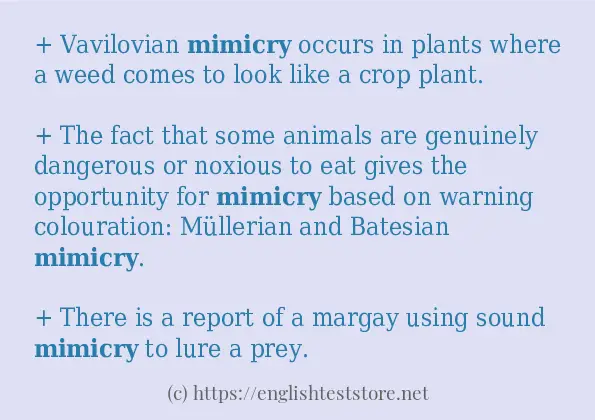How to use in-sentence of “mimicry”:
+ Vavilovian mimicry occurs in plants where a weed comes to look like a crop plant.
+ The fact that some animals are genuinely dangerous or noxious to eat gives the opportunity for mimicry based on warning colouration: Müllerian and Batesian mimicry.
+ There is a report of a margay using sound mimicry to lure a prey.
+ Müllerian mimicry is a shared warning advertisement, in this case of foul taste.
+ This type of mimicry is quite common.

Example sentences of “mimicry”:
+ A possible case of mimicry in larger mammals.
+ Parallel race formation and the evolution of mimicry in “Heliconius” butterflies: a phylogenetic hypothesis from mitochondrial DNA sequences.
+ Often their mimicry is not perfect, and you can easily tell them apart once they have settled.
+ This naturalist and explorer gave the first scientific account of mimicry in animals.
+ Almost all forms of mimicry involve appropriate behaviour to reinforce the visual impression.
+ It is a fine example of how behaviour and mimicry work together.
+ In biology, mimicry is when a species evolves features similar to another.
+ In the second half of the 20th century, population geneticists tackled a range of complex evolutionary problems, such as the evolution of sex, sexual selection, kin selection, mimicry and molecular evolution.
+ This is interesting because it shows this type of mimicry evolved long before flowering plants arose.
+ Hoverflies are harmless to most other animals despite their mimicry of the black and yellow stripes of wasps.
+ All three traveller-naturalists believed firmly that such systems of mimicry could only come about by means of natural selection, and all of them wrote about it.
+ Mani started his career as a mimicry artist with the Kalabhavan troupe.
+ A possible case of mimicry in larger mammals.
+ Parallel race formation and the evolution of mimicry in "Heliconius" butterflies: a phylogenetic hypothesis from mitochondrial DNA sequences.
+ Often their mimicry is not perfect, and you can easily tell them apart once they have settled.
